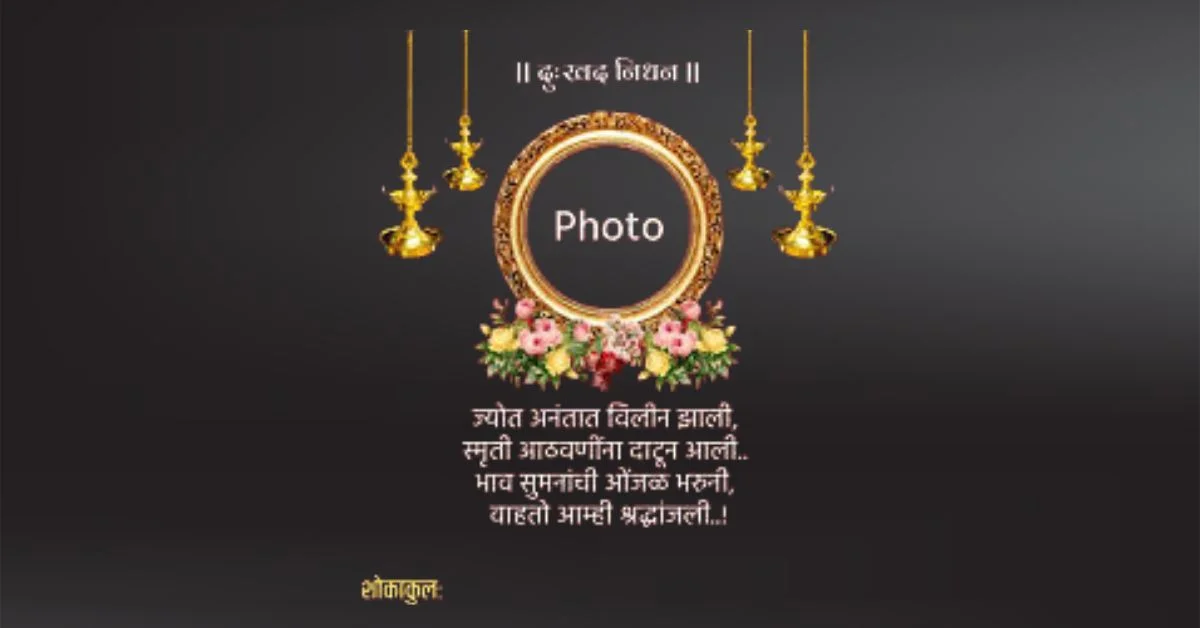In the cultural tapestry of Maharashtra and other Marathi-speaking communities, Bhavpurna Shradhanjali is a deeply meaningful expression. It translates to “heartfelt tribute” and is often used to honor the memory of someone who has passed away. Whether it appears in newspapers, street posters, community halls, or digital platforms, a “Bhavpurna Shradhanjali in Marathi banner” serves not only as a public notice but as an emotional, respectful farewell.
If you’re searching for this phrase, you’re likely trying to understand how to design or write a Bhavpurna Shradhanjali banner in Marathi, what it should include, what tone is appropriate, or how to represent the departed person with dignity and warmth. This guide answers all of that and more.
The content is meant to be timeless, respectful, and practically useful, combining cultural understanding with design sensibility, updated for how these banners appear both offline and online today.
What Does “Bhavpurna Shradhanjali” Mean?
In Marathi, भावपूर्ण श्रद्धांजली (Bhavpurna Shradhanjali) is composed of two words:
- भावपूर्ण: heartfelt, emotional, or filled with sentiment
- श्रद्धांजली: tribute, homage, or a respectful offering made with devotion
Together, the phrase represents a deeply respectful and emotional farewell to someone who has passed away. It’s typically used in memorial messages, condolence posters, social media graphics, obituary columns, and physical banners displayed in neighborhoods or community halls.
Purpose of a Bhavpurna Shradhanjali Banner
The main purpose of such a banner is to:
- Honor the life and memory of the deceased
- Notify the community of the individual’s passing and any rituals planned
- Express collective mourning and respect
- Preserve emotional memories visually
While it is culturally grounded, the format and style of such banners have evolved in recent years, especially with digital usage on platforms like WhatsApp, Facebook, and even digital boards in urban localities.
Key Elements of a Bhavpurna Shradhanjali Banner
1. Photograph of the Deceased
- A central, high-resolution image (preferably a smiling, formal photo)
- Often framed in white or garlanded in the design
- Black-and-white or sepia tone for added solemnity
2. Name and Titles
- Full name in large font
- Optional inclusion of affectionate titles like Baba, Aai, Kaka, Mavshi, etc.
3. Dates
- Date of birth and date of death (जन्म तारीख – मृत्यू तारीख)
4. Heading (Top Banner Text)
- भावपूर्ण श्रद्धांजली
- श्रद्धांजली वाहत आहोत…
- आमच्या प्रिय… यांना विनम्र श्रद्धांजली
These act as emotional markers to draw attention respectfully.
5. Message Body
Often includes:
- A short tribute or poem in Marathi
- Details about virtues, contribution, or role of the person
- Funeral or ritual details (optional, if it’s a public banner)
6. From Whom
- Names of family members, friends, or organizations
- Sometimes accompanied by “कुटुंबिय” or “आप्तेष्ट” (relatives)
7. Design Aesthetics
- Muted tones like white, grey, maroon, or beige
- Simple floral borders or diya (lamp) illustrations
- Use of respectful Marathi fonts (like Shree-Lipi, LMG Arun)
Sample Banner Text in Marathi
Here’s a sample layout text that can be used or adapted:
भावपूर्ण श्रद्धांजली
(श्री. रमेश महादेव देशमुख)
(२ जानेवारी १९५५ – १५ जुलै २०२५)
“तुमच्या आठवणी आमच्या हृदयात सदैव राहतील.
तुमचा प्रेमळ स्वभाव, मार्गदर्शन आणि हसरा चेहरा आम्हाला कायम प्रेरणा देईल.”
आपले:
देशमुख कुटुंबीय व नातेवाईक
Digital vs. Physical Banner Usage
Physical Banners
- Placed outside homes, on community noticeboards, or near religious halls
- Sizes vary: 3ft x 2ft (common), larger for public figures
- Printed using flex boards with vinyl finishing
Digital Banners
- Shared on WhatsApp, Facebook, or community forums
- Often adapted to square (for posts) or vertical mobile-friendly dimensions
- Easy to add music, transitions, or animated garlands in video versions
Design Tips:
- Ensure legibility: Use clear fonts, avoid decorative or cursive styles
- Keep contrast high between text and background
- Avoid too many colors—respectful tones evoke solemnity better
- Use vector floral garlands or diya icons subtly
Cultural Sensitivity in Marathi Mourning Traditions
Marathi mourning traditions involve both rituals and symbolic expressions. Bhavpurna Shradhanjali is part of this symbolic language. When creating a banner:
- Avoid overly cheerful designs
- Do not include loud music or festive themes
- Focus on dignity, respect, and emotional balance
- Understand regional or caste-based customs before finalizing banner details
For example, in rural Maharashtra, large banners are often community expressions. In cities, minimalistic designs for digital sharing are more common.
Fonts That Complement Marathi Shradhanjali Banners
For designers, font selection is crucial. Here are some Marathi-compatible fonts that suit the purpose:
- Shree Dev0714
- Kiran Font
- Modak Devanagari (for headline elegance)
- Sakal Marathi
- Mangal (System font)
All text should be in Unicode to ensure proper rendering across devices and printers.
Common Messages and Verses Used
Here are some common Marathi condolence verses used in such banners:
“स्मृतींच्या गंधात तुझी आठवण राहील,
निसटलेली हसरी सावली आयुष्यभर साथ देईल.”
“माणूस गेला तरी आठवणींचा झरा चालूच राहतो,
तुझा प्रेमळ स्वभाव आमच्यासोबत सदैव राहील.”
“तुमचा मार्गदर्शक हात आता नाही,
पण तुमचे विचार आमचे जीवन घडवत राहतील.”
Such messages add a personal and poetic touch, comforting those who read them.
Professional Banner Services
If you’re not comfortable designing the banner yourself, here are your options:
- Local printing shops: Most have templates ready
- Freelance designers: On platforms like Fiverr or local freelance groups
- Online design tools: Canva, PosterMyWall, or Adobe Express with Marathi font support
- Mobile apps: Several Marathi-specific condolence banner apps now exist with pre-built layouts
Most professionals deliver digital + print versions for convenience.
Social Media and Modern Expression
In recent years, especially post-COVID, Bhavpurna Shradhanjali banners have become common on social platforms. These have shifted the format slightly:
- Use of profile photos
- Inclusion of soft instrumental music
- Slideshow videos of memories
- Caption hashtags like #भावपूर्णश्रद्धांजली or #RIP with emojis (though traditional families may avoid emojis)
This digitization has made expressing grief more immediate, wider in reach, and sometimes even interactive with comment sections serving as condolence books.
Ethical Considerations
While creating and sharing such banners:
- Confirm information (especially dates and names) before publishing
- Take consent from close family before posting online
- Avoid political or promotional messaging
- Don’t use stock photos of unrelated deities or symbols that the family doesn’t endorse
Conclusion
A Bhavpurna Shradhanjali in Marathi banner is more than a design project—it’s an emotional and cultural offering that combines respect, memory, and community togetherness. Whether it appears as a roadside banner in a village or a digital card in a WhatsApp group, its message is universal: “You are remembered. You are missed. You are honored.”
Understanding the structure, tone, and cultural roots of such banners allows us to engage with grief and remembrance more meaningfully. In a time where even mourning has adapted to screens and timelines, the essence of Bhavpurna Shradhanjali remains the same—a heartfelt farewell from those who remain to those who have moved on.
Frequently Asked Questions (FAQs)
1. What does “Bhavpurna Shradhanjali” mean in Marathi?
It means “heartfelt tribute” and is used to respectfully honor the memory of a deceased person.
2. What should I include in a Bhavpurna Shradhanjali banner?
Include the person’s photo, full name, birth/death dates, tribute message, and family names in respectful Marathi script.
3. Are digital Shradhanjali banners appropriate?
Yes, especially on social media or messaging apps. They are commonly used and widely accepted today.
4. Which font is best for Marathi condolence banners?
Fonts like Shree Dev0714, Mangal, or Modak Devanagari are visually clear and culturally suitable.
5. Is it okay to use poetry or verses in the banner?
Absolutely. Short, emotional Marathi poems or verses often make the banner more personal and meaningful.
For more information, click here.









